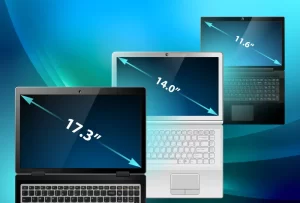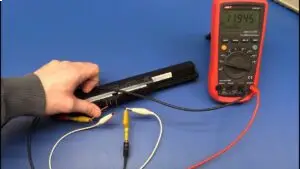Finding The Right Fit: How To Measure Laptop Size Step-by-Step
How To Measure Laptop Size

To measure a laptop size, close it and measure diagonally from the top-left to the bottom-right corner of the screen, excluding the bezel. This standard screen measurement, typically between 11 and 17 inches, is key for choosing compatible bags and accessories. Accurate sizing helps you compare models and select the right laptop for your needs, whether for portability or a larger display.

Measuring Your Laptop Dimension
Understanding how to measure your laptop’s dimensions is crucial whether you’re buying a new case, planning travel accommodations, or simply curious about the size of your device. Get ready to arm yourself with the knowledge and tools you’ll need to precisely measure your laptop’s size. Accurate measurements ensure perfect fits and informed choices. Let’s dive into the specifics of measuring your laptop’s physical dimensions.
Why Size Measurement Is Important
Knowing the exact size of your laptop is essential for several reasons. It ensures that protective cases, sleeves, and bags you purchase will fit snugly, reducing the risk of damage. When traveling, knowing your laptop’s size can help with security checks and meet airline guidelines. Additionally, accurate dimensions are beneficial when setting up an ergonomic workspace, as they assist in finding the right accessories to complement your laptop.
Tools Needed For Measuring Laptop Size
- Tape Measure: A flexible tape measure is ideal for measuring curved edges.
- Ruler or Straightedge: A long ruler is useful for laptops with larger screens.
- Notebook or App: To record measurements, have a notebook or a digital note-taking app ready.
Preparing Your Laptop For Measurement
- Turn off your laptop and disconnect any cables or peripherals to avoid interference.
- Close the laptop lid to get an accurate width and length measurement.
- Clear a flat and clean surface to place your laptop on, which ensures an even, level measuring base.
With your tools in hand and laptop prepared, you’re all set to start measuring. Gently place your measuring tool of choice on the laptop, starting from the top-left corner to the bottom-right corner for diagonal screen size, stretching it edge to edge for width, and from front to back for depth if necessary. Record each measurement carefully for future reference, and compare against product details when shopping for laptop-related items.

Credit: Youtube
Steps In How To Measure Laptop Size
Whether you’re purchasing a new laptop sleeve, upgrading your current setup, or simply curious about the dimensions of your device, knowing how to accurately measure your laptop size is essential. The size of a laptop can impact its portability, usability, and the type of case or bag that will fit it. The following steps will guide you through the process of gathering precise measurements of your laptop:
Find The Diagonal Screen Size
Measuring the screen diagonally is the most common way to determine a laptop’s size. Grab your measuring tape and place one end at the bottom-left corner of the laptop screen (but not including the bezel) and extend it to the top-right corner. This measurement gives you the screen size, which is what manufacturers typically use to classify laptops.
Measure The Width Of The Laptop
When assessing the width, close your laptop and measure the horizontal dimension. Place one end of your measuring tape on the left side of the laptop and extend it to the right side. Record the value you get as it is crucial for finding a well-fitting bag or a sleeve.
Determining The Laptop’s Depth
The depth of your laptop is equivalent to its front-to-back measurement when closed. Begin measuring from the front edge and extend your tape measure to the rear edge. Make sure the laptop is fully closed to obtain an accurate reading.
Recording The Height Of The Laptop
To record the height of the laptop, you need to measure from the bottom to the highest point with the laptop closed. This dimension becomes particularly important if you’re dealing with a thicker, more robust laptop, as you’ll need a bigger case or sleeve.
After completing these steps, you’ll have the exact dimensions of your laptop, helping you make informed decisions for accessories and cases. Always write down the measurements and keep them handy for reference.
Laptop Size Chart And Comparison
Choosing the right laptop can be a nuanced process, involving various factors like performance, battery life, and portability. One of the most fundamental aspects to consider is the laptop’s size, which not only influences the display you’ll work with but also the device’s overall portability. Understanding the nuances between laptop sizes and how they correlate with their uses can help in making an informed decision. The Laptop Size Chart provides a detailed comparison and is an essential tool for differentiating between the numerous available options.
Standard Laptop Sizes And Their Uses
Standard laptop sizes are generally categorized based on their screen diagonal, which can range from as small as 11 inches to as large as 17 inches or more. Here’s a quick rundown:
- 11-12 inches: The most portable devices, ideal for on-the-go users who prioritize light weight and compactness over screen real estate.
- 13-14 inches: Balancing portability with usability, these laptops are well-suited for students and professionals who need a machine that’s easy to carry without sacrificing performance.
- 15 inches: A standard size for most work and play activities, offering a larger screen and typically room for better hardware, without being too cumbersome.
- 17 inches and up: Perfect for gamers and creative professionals who require a spacious display and top-tier specifications, though these units can be less portable.
How To Use Size Charts Effectively
Size charts are invaluable tools that offer insights into the various dimensions and specs of laptops. To make the most out of them:
- Identify the primary purpose of the laptop to determine the most fitting size range.
- Refer to the size chart for the dimensions of the laptop, ensuring that it includes width, depth, and height for a full understanding of the device’s size.
- Consider the weight listed in the chart, as this can impact portability.
- Check the screen resolution and aspect ratio, which are often correlated with size and will affect visual workflows and entertainment experiences.
- Map the size and specs against your needs, balancing trade-offs between performance, portability, and price.
| Size (Inches) | Typical Use | Width (Inches) | Depth (Inches) | Weight (Pounds) |
|---|---|---|---|---|
| 11-12 | High Mobility | 11.5 | 8 | 2-3 |
| 13-14 | Balance of Mobility and Performance | 12.8 | 9 | 3-4.5 |
| 15 | Work and Play | 14.1 | 9.6 | 4.5-5.5 |
| 17+ | Gaming and Professional Use | 15.5 | 11 | 6+ |
Ensuring Accuracy In Measurements
When you’re in the market for a new laptop bag or sleeve, knowing your laptop’s exact size is paramount. This avoids the inconvenience of purchasing an ill-fitting case that’s either too snug or too loose. Accurate measurements not only ensure a perfect fit but also safeguard your computer during transport. Let’s dive into how to measure your laptop correctly, highlighting common pitfalls and tips to enhance precision.
Common Mistakes To Avoid
Accuracy is crucial when it comes to measuring your laptop, as minor errors can lead to significant problems later. Be wary of these common mistakes:
- Not accounting for laptop corners: Rounding off corner measurements can misguide your perception of size.
- Ignoring protrusions: Failing to include any external features such as hinges or clamps that might affect the fit.
- Confusing dimensions: Mixing up the length, width, and height measurements is a common blunder.
- Using the wrong tools: Employing a fabric tape measure instead of a rigid one can distort the measurements.
Tips For Precise Measurement
To avoid these mistakes and ensure that you get the dimensions right, follow these tips:
- Use a rigid measuring tape or ruler for better stability and accuracy.
- Lay your laptop on a flat surface to ensure an even base for correct measurements.
- Measure diagonally across the screen for the display size, not including the bezel.
- Record the width, depth, and height of your laptop from its widest points, including any protuberances.
- Write down your measurements immediately to avoid forgetting or mixing them up.
- Double-check your numbers to confirm their precision.
Remember, spending a few additional minutes on measuring can spare you the headache of return processes and protect your laptop from potential damage due to unfitting covers.
Selecting The Right Bag Or Case
Once the laptop’s dimensions are clear, finding a compatible bag or case is the next crucial step. The perfect fit provides protection and convenience, transforming into a smart mobile workstation. The quest for the ideal laptop bag or case begins with understanding why the right sizing is non-negotiable.
Importance Of Accurate Laptop Size
Protecting your investment is essential. A snug-fitting bag or case guards against impact and prevents shifting during transportation. These accessories come in various sizes, styles, and materials, and your selection must resonate with your laptop’s specific dimensions to avoid damage and maintain functionality.
Matching Laptop Dimensions To Bag Sizes
Begin the matching process by recording your laptop’s exact width, depth, and height. A table often clarifies the comparison:
| Laptop Size | Bag/Case Dimensions |
|---|---|
| 13-inch | Minimum 13.5″ x 9.3″ x 1.2″ |
| 15-inch | Minimum 15.5″ x 10.5″ x 1.2″ |
| 17-inch | Minimum 17.3″ x 11.5″ x 1.2″ |
After collecting this data, scout for a bag matching or slightly exceeding these measurements. Consider extra pockets for accessories, and choose a design offering accessible compartments and comfortable handles or straps. Remember, a well-fitted case enhances portability and ensures longevity for your device.

Credit: www.laptopscreen.com
Frequently Asked Questions Of How To Measure Laptop Size
What’s The Proper Way To Measure A Laptop?
To measure a laptop, close it first and measure diagonally across the top of the screen casing. Don’t include the bezel or any part of the base. This measurement in inches is your laptop’s screen size.
How Can I Find Out My Laptop’s Dimensions?
You can find your laptop’s dimensions by using a tape measure to record the length, width, and height while closed. Measure from edge to edge to get accurate numbers, which are typically listed in that order.
Does Screen Size Include The Bezel?
No, the screen size does not include the bezel. It only measures the active display area within the bezel. Always measure just the screen where the video is displayed, not including any part of the surrounding frame.
Can I Use A Ruler To Measure My Laptop Screen?
Yes, a ruler can be used to measure the laptop screen. Ensure it’s long enough to measure the screen diagonally from corner to corner without including the bezel, for an accurate size.
Conclusion
Finding the perfect laptop size doesn’t have to be complicated. With the simple measuring techniques outlined, you can confidently navigate your options. Remember, accurate measurements ensure a snug fit for your device, matching it with cases and accessories. Start measuring, and unlock the best fit for your tech lifestyle!

I am a technology Specialized writer and blogger based in the USA & UK. I have four years of experience in Cyber Security, Technology, Social Media and all types of electronic devices like computer laptops etc. So I work on solving these issues and give various tips on these issues



